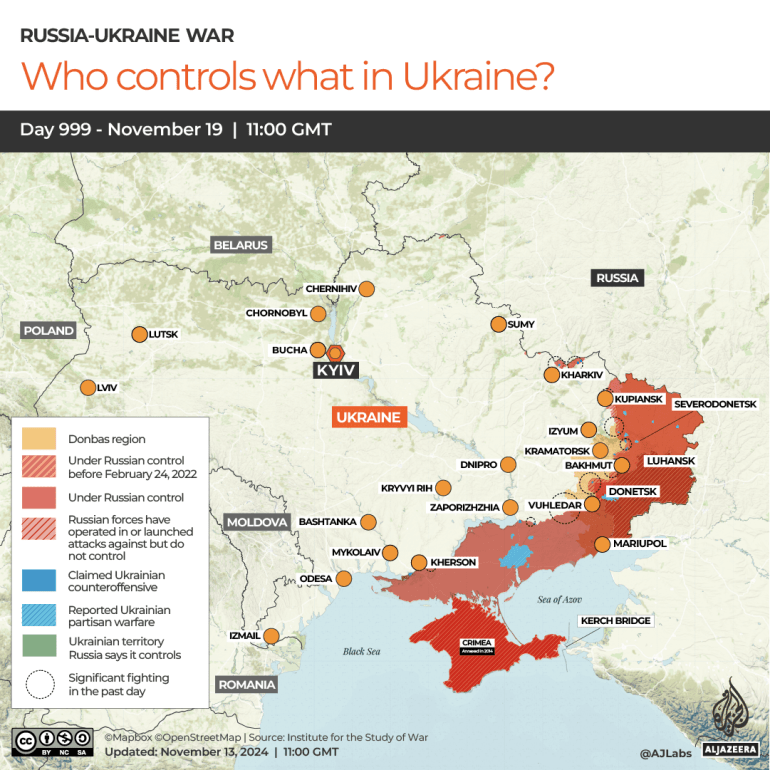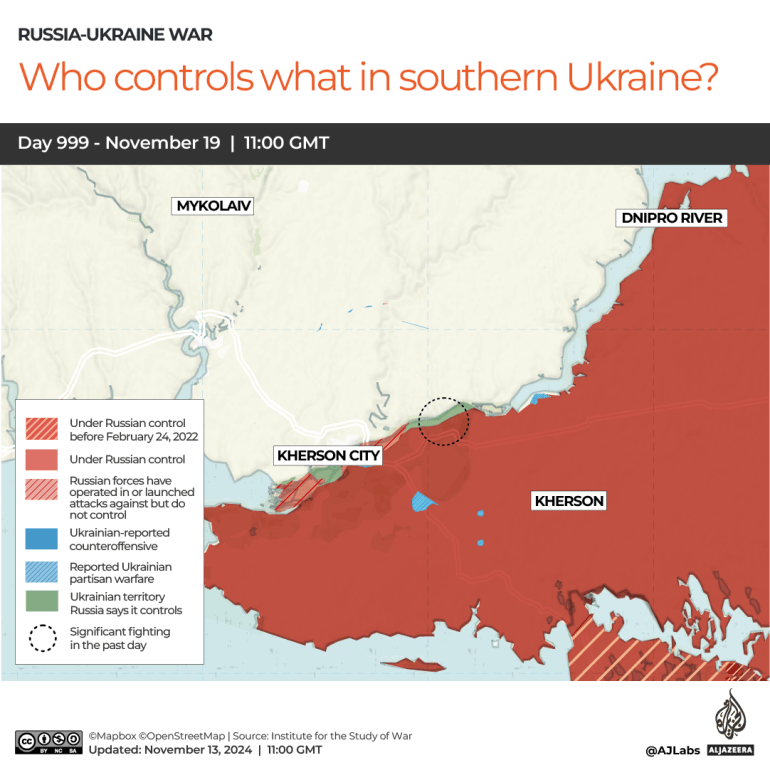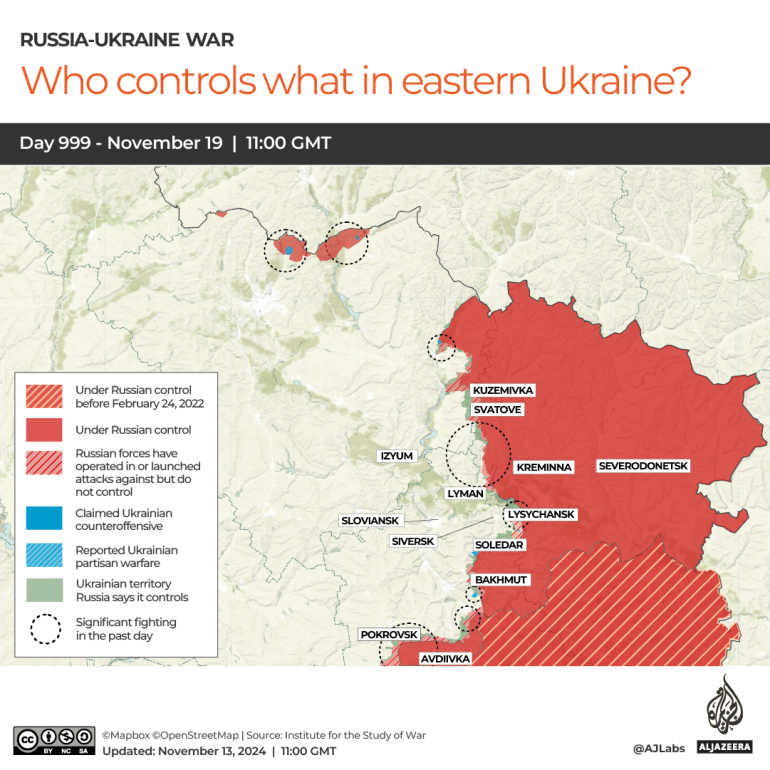The European Union and US President Joe Biden are taking unprecedented steps to bolster Ukrainian and European defences following Donald Trump’s November 5 presidential election victory and North Korea’s involvement in the Ukraine war with troops.
Trump has expressed scepticism about supplying military aid to Ukraine and keeping the United States engaged in NATO.
North Korea has sent 11,000 troops to fight in Russia’s Kursk region, where Ukraine has staged a counter-invasion since August.
The EU will be informing member states they may divert up to 372 billion euros ($392bn) in Brussels subsidies to military purposes, the Financial Times reported last week, quoting officials in Brussels.
Ukraine’s Foreign Intelligence Service also reported the impending policy shift.
That money represents unspent amounts from the Cohesion Fund, which normally finances growth-stimulating projects in poorer EU regions.
The money could be spent on dual-purpose infrastructure, such as roads and bridges that have military importance, or equipment, such as vehicles and drones, the FT reported.
The Biden administration is meanwhile rushing to draw down $7.1bn in military equipment and ammunition from stockpiles to send to Ukraine “almost weekly” before Trump assumes office on January 20.
The most controversial decision, however, was Biden’s reversal of a ban on the use of US weapons 300km inside Russia (185 miles).
The Washington Post and New York Times on Sunday quoted unnamed administration officials saying Ukraine was being authorised to use US Army Tactical Missiles (ATACMS) in Russia’s Kursk region, where it is holding at bay some 50,000 Russian and North Korean troops.
Maria Zakharova, Russia’s foreign ministry spokesperson, said the move amounted to “direct involvement of the US and its satellites” and that Russia’s response would be “appropriate and tangible”.
On Thursday, Ukraine said Russia fired an intercontinental ballistic missile as part of an assault on Ukraine’s central-eastern city of Dnipro.
Biden’s decision divided Europe.
Britain and France, which supply Ukraine with SCALP/Storm Shadow missiles of 250km (155-mile) range and have supported lifting the ban immediately, authorised their missiles’ use inside Russia’s Kursk region as well.
Last week, France completed training and equipping a new Ukrainian brigade.
But Germany has stuck to its policy of refusing to supply Ukraine with its 500km-range (310-mile) Taurus missile, and a brigade it promises to lead in Lithuania will not be combat-ready until 2027.
Last week German Chancellor Olaf Scholz passionately defended his caution in the Bundestag as an avoidance of escalation.
Scholz further enraged other European leaders on Friday when he telephoned Russian President Vladimir Putin.
Putin has not spoken with Biden or an EU head of government since the end of 2022, the first year of his full-blown invasion of Ukraine.
“As far as I know it was quite a businesslike conversation, detailed and quite frank, as the sides laid out their positions mutually,” said Kremlin spokesman Dmitry Peskov.
He said aides to Scholz and Putin would meet this year on a “range of issues”.
US retired general Ben Hodges recently lamented this lack of allied unity.
“I do believe we missed an opportunity last year,” he told Al Jazeera. “If we had been committed – US, UK, Germany, France – had been committed to helping Ukraine win and provided what was needed early on, then I think we’d be talking about a much different situation right now.”
Russian messaging quickly doubled down on the division within Europe.
“[French President Emmanuel] Macron has been one of the most vocal and biggest material supporters of the war, advocating for victory over Russia, for Russia’s strategic defeat,” Russian Foreign Minister Sergey Lavrov said at the G20 summit in Rio de Janeiro. “Scholz has repeatedly said that this is his principled position, despite all the criticism … Well, I think Scholz’s position is a responsible stance.”
Hungary, which has argued against EU sanctions against Russia, also broke ranks with the EU over Biden’s licensing of Ukrainian deep strikes.
“The threat of the escalation of the Ukraine-Russia war is greater than ever,” Hungarian defence minister Kristof Szalay-Bobrovniczky said on Thursday.
Hungary said it would place an air defence system on its border with Ukraine, and Prime Minister Viktor Orban, who currently holds the rotating presidency of the EU, convened a meeting of Europe’s defence council to discuss the danger of escalation.
Since Trump’s election, Russia has postured as a peacemaker in the war it started.
“The president has repeatedly and consistently stated his readiness for contact and negotiations,” Peskov said this week.
But Putin also reminded Scholz that his terms were Ukraine’s complete withdrawal from “Novorossiya”, a reference to the five Ukrainian provinces he currently partly occupies.
Russia’s ‘demonstrative hits’ on the front lines
Russia’s posture on the ground has been anything but peaceful.
Its attacks have increased ahead of winter and so have its casualties.
Ukrainian ground forces commander Oleksandr Pavlyuk estimated Russian casualties at 12,000 last week, a daily average of at least 1,700. That is about 300 people a day more than the week before.
Al Jazeera was unable to confirm the estimate.
Russia also killed 11 civilians and injured more than 80 when it fired S-300 anti-air missiles into a residential neighbourhood in the northern Ukrainian city of Sumy on Sunday, two days after the Scholz phone call and the night before Biden’s decision to allow Ukraine to use ATACMS was made public.
The missiles were part of a record strike including 120 missiles and 90 UAVs. Ukraine shot down 102 missiles and 42 UAVs while disorienting another 41 UAVs with electronic warfare systems.
The following day, a Russian Iskander ballistic missile struck Odesa killing 10 people and injuring 39, said Ukrainian police.
“These are not random hits – they are demonstrative hits. After the calls and meetings with Putin, after all the false gossip in the media about allegedly ‘refraining’ from strikes, Russia shows what it is really interested in: only war,” said Ukrainian President Volodymyr Zelenskyy, in a reference to Scholz’s phone call to Putin.
Ukraine made its first confirmed use of ATACMS 120km (75 miles) inside Russia on Tuesday, when it struck the 1046th logistics centre near Karachev in the Bryansk region, causing a dozen secondary explosions.
Andriy Kovalenko, the head of Ukraine’s Center for Countering Disinformation, said the depot contained artillery rounds, glide bombs and surface-to-air missiles.
Russia’s defence ministry said it had shot down five incoming ATACMS missiles and damaged a sixth; falling fragments caused a fire.
On Wednesday, Ukraine reportedly fired a dozen Storm Shadow cruise missiles at a joint Russian-North Korean command headquarters located at Maryno, in Russia’s Kursk region, 40km (25 miles) from the Ukrainian border and 30km from the front line of Ukraine’s counter-invasion.
Ukraine has been asking Biden for permission to strike deep inside Russia with Western weapons for months.
Even though Russia has moved back many of its most valuable assets, including helicopters and the Tupolev-95 bombers it uses to launch devastatingly effective glide bombs, more than 200 targets are within range of ATACMS, including ammunition depots and command posts, said the Institute for the Study of War, a Washington-based think tank, in an August report. Ukraine appeared to be targeting those.
“US officials are only now seriously evaluating depriving Russia of a sanctuary from which Russia wages war against Ukraine,” wrote the ISW in an evaluation of Biden’s latest move. “Ukraine has not yet been provided an opportunity to demonstrate what Ukrainian forces can achieve when properly resourced.”
Missile supply is also an issue.
Some US officials have reportedly argued against supplying ATACMS to Ukraine on the grounds that the US has a limited supply.
Britain and France also have limited stocks of Storm Shadows.
A year ago, Ukraine launched a policy of manufacturing as many of its own weapons as possible, to cut costs and circumvent policies it sees as overcautious.
“Today we are increasing the production of Ukrainian missiles,” said Ukrainian defence minister Rustem Umerov on Monday. “The first 100 rockets of this year have already been produced,” he said, referring to Neptune antiship missiles. Zelenskyy said Ukraine was testing four types of missiles that it intends to mass-produce.
“War is a test of will and a test of logistics. Ukrainians have plenty of will. They just don’t have enough logistics,” Hodges told Al Jazeera. “We in the West have almost endless amounts of logistics but we don’t have the political will.”